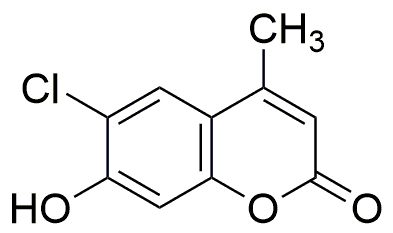6-Chloro-7-hydroxy-4-methylcoumarin is widely utilized in research focused on:
- Fluorescent Probes: This compound is often used as a fluorescent marker in biological studies, allowing researchers to visualize cellular processes and track biomolecules in real-time.
- Antimicrobial Agents: Its antimicrobial properties make it valuable in the development of new antibiotics, particularly against resistant strains of bacteria.
- Photodynamic Therapy: In the medical field, it is explored for use in photodynamic therapy, where it helps in targeting and destroying cancer cells when activated by light.
- Analytical Chemistry: The compound serves as a standard in analytical methods for detecting and quantifying other substances, enhancing the accuracy of chemical analysis.
- Cosmetic Applications: Due to its antioxidant properties, it is incorporated into skincare products to help protect the skin from oxidative stress and improve overall skin health.
General Information
Properties
Safety and Regulations
Applications
6-Chloro-7-hydroxy-4-methylcoumarin is widely utilized in research focused on:
- Fluorescent Probes: This compound is often used as a fluorescent marker in biological studies, allowing researchers to visualize cellular processes and track biomolecules in real-time.
- Antimicrobial Agents: Its antimicrobial properties make it valuable in the development of new antibiotics, particularly against resistant strains of bacteria.
- Photodynamic Therapy: In the medical field, it is explored for use in photodynamic therapy, where it helps in targeting and destroying cancer cells when activated by light.
- Analytical Chemistry: The compound serves as a standard in analytical methods for detecting and quantifying other substances, enhancing the accuracy of chemical analysis.
- Cosmetic Applications: Due to its antioxidant properties, it is incorporated into skincare products to help protect the skin from oxidative stress and improve overall skin health.
Documents
Safety Data Sheets (SDS)
The SDS provides comprehensive safety information on handling, storage, and disposal of the product.
Product Specification (PS)
The PS provides a comprehensive breakdown of the product’s properties, including chemical composition, physical state, purity, and storage requirements. It also details acceptable quality ranges and the product's intended applications.
Certificates of Analysis (COA)
Search for Certificates of Analysis (COA) by entering the products Lot Number. Lot and Batch Numbers can be found on a product’s label following the words ‘Lot’ or ‘Batch’.
*Catalog Number
*Lot Number
Certificates Of Origin (COO)
This COO confirms the country where the product was manufactured, and also details the materials and components used in it and whether it is derived from natural, synthetic, or other specific sources. This certificate may be required for customs, trade, and regulatory compliance.
*Catalog Number
*Lot Number
Safety Data Sheets (SDS)
The SDS provides comprehensive safety information on handling, storage, and disposal of the product.
DownloadProduct Specification (PS)
The PS provides a comprehensive breakdown of the product’s properties, including chemical composition, physical state, purity, and storage requirements. It also details acceptable quality ranges and the product's intended applications.
DownloadCertificates of Analysis (COA)
Search for Certificates of Analysis (COA) by entering the products Lot Number. Lot and Batch Numbers can be found on a product’s label following the words ‘Lot’ or ‘Batch’.
*Catalog Number
*Lot Number
Certificates Of Origin (COO)
This COO confirms the country where the product was manufactured, and also details the materials and components used in it and whether it is derived from natural, synthetic, or other specific sources. This certificate may be required for customs, trade, and regulatory compliance.


